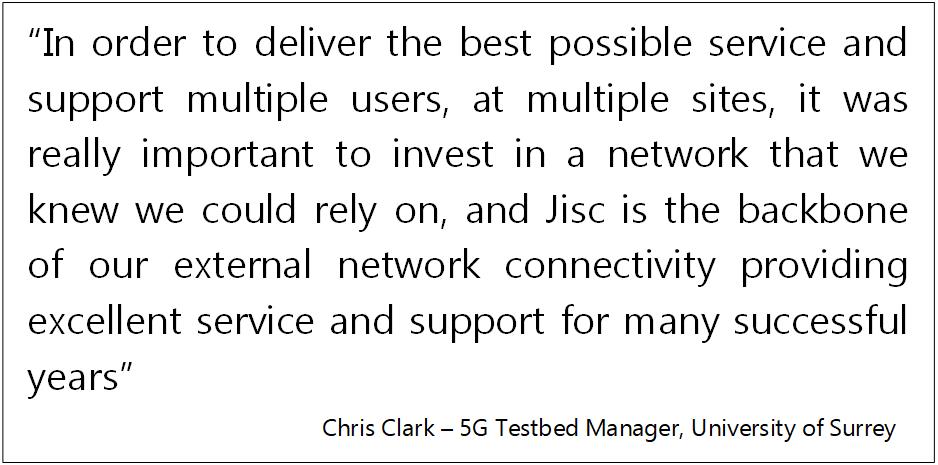This article explores what Jisc is doing to support 5G activities across the UK, and how 5G technology is being trialled as a way of providing connectivity to Jisc members and customers.
Note: Jisc is not planning to provide a 5G service, more looking at how 5G could be used as an alternative technology to provide existing Janet connectivity services. Also Jisc is not a mobile operator, and has no intention of becoming one.
Supporting 5G/6G research
Jisc has been working with the University of Surrey, specifically its 5G/6G Innovation Centre (5GIC) , for over 5 years now, providing high capacity connectivity to both Janet and also to partner organisations (University of Bristol and King’s College London) and shared 5G resources located at the Jisc Shared Data Centre in Slough. Those arrangements have also evolved and resulted in the provision of further connectivity from 5GIC to other 5G initiatives across the UK. Jisc and Janet are firmly embedded in this area and will continue to support for the benefit of our members and the wider 5G community.
Janet connectivity via 5G
We’re looking at how 5G could be used as a way of providing connectivity services to customers. At the moment this is firmly in the initial alpha/trial phase (5G hardware only arrived on site in October), but depending on how that goes it could be extended further.
The Problem
A common problem we face is delays with delivery of fibre based connectivity products, usually down to the well known issues and complications that come with getting infrastructure ‘in the ground’. In the past we’ve considered wireless/microwave type solutions to provide shorter term / emergency connectivity, but have always ruled it out due to the often prohibitive cost, and also issues with installing infrastructure on the roof of buildings. We’ve simply had to wait for fixed line products to be delivered, which in some cases causes issues where we or our customers are up against hard deadlines requiring service to be in place.
Phase 1: initial on-site trials
One of our customers had a need for connectivity at very short notice due to a building move where existing connectivity couldn’t be moved to the new location quickly enough. Working with Cradlepoint we’ve deployed a 5G device onsite equipped with SIM cards from 2 providers, and are providing basic internet connectivity to the site via those mobile networks. Initial trials have been positive with download speeds peaking towards 500Mbit/s. In a non-city centre location, without direct line of sight to any mobile masts, this was a surprising and impressive result. There were a few minor teething problems with the location of the device and data caps on the SIM cards, but those have now been overcome and the customer is seeing a good reliable service as a result. This was deployed within 2 weeks of us giving the go-ahead.

Phase 2: advanced lab trials
This phase probably should have come first, before we deployed to a customer site, but needs must and we had a problem to solve. What we’ll be doing next is some more planned and controlled lab work at the Janet NOC in London, and at other strategically useful locations, to properly test the hardware, the management platform, the mobile phone app, etc. We’ll also be looking at what infrastructure will be required to support tunnelling these services back to Janet, so that to the end customer is operates as a Janet IP connection rather than a mobile internet connection. Hardware to support these trials is with us (again thanks to Cradlepoint) and work will begin imminently.
Phase 3: formal adoption
As mentioned at the beginning of the article, we’re not launching a ‘Janet 5G’ service, the aim is for us to use this technology to support the provision of existing connectivity services – IP, intersite, etc. It all depends how the trials go of course, but the expectation at this stage is that this method of provision will be ideal for short term / emergency requirements, as we’re doing at the moment, and also as backup for fibre based primary connectivity to end sites. This thinking will develop over the coming months as trials are carried out, so watch this space for further updates on how the work progresses.
